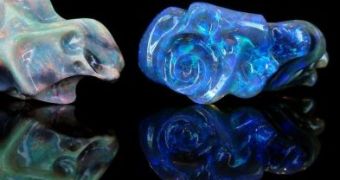Opal is one of the most precious gemstones people prefer. Scientists believe that the beautiful display of color this precious stone shows is mainly due to tiny amounts of uranium present in the composition of the stone. This discovery could prove to be valuable information for the artificial opal industry.
The discovery of the presence of uranium traces in the opal gemstones was made by studying the amount of gamma-ray radiation emitted by the uranium and some other radioactive elements, which could shed new light on how opal gemstone deposits develop.
The opal mineraloid is amorphous hydrated silicon dioxide, which could contain water as high as 20 percent, but the average quantity represents three to ten percent. Opal gems come in a variety of colors, of which red and black are the rarest and most precious ones. Opal stone is relatively hard to find due to the fact that they mostly form in the cracks of rocks made out of the same material. Precious opal gems differ from the less valuable and common opal by its structure which implies that the crystal is made out of silica spheres about 200 nm in diameter, arranged in a regular superlattice. Opal is mostly famous for the different display of playful colors, which can be observed when viewed from different angles, due to the light diffraction properties.
Geologists believe that superlattice structure formation is triggered by the presence of small amounts of uranium and other products resulted in the spontaneous radioactive decay of the uranium nuclei. By simulating different sedimentation models and analyzing opal stone through electron spectroscopy, the researchers have shown that heavy chemical elements such as uranium act as a seed for the formation of silica sphere.
Due to the presence of uranium, precious opal is also more radioactive than the surrounding rocks that generally emit a low level of radiation. Because the precious opal containing small amounts of uranium emits gamma-ray, this can be used to create a new technique for finding opal.
With the help of gamma-ray detectors, the exact position of the opal deposit can be triangulated. Though Australia is currently producing more than 90 percent of the total precious opal extracted in the world, geologist Brian Senior speaks about a 'cottage industry'.
The team is now trying to find out whether this information could provide valuable data on the formation of opal gems in artificial environments, which might offer the possibility of producing opal engineered photonic crystals that could manipulate light in the same way electric circuits control current flows.

 14 DAY TRIAL //
14 DAY TRIAL //